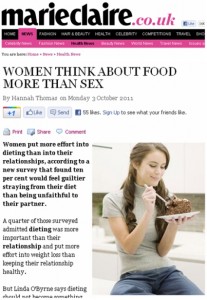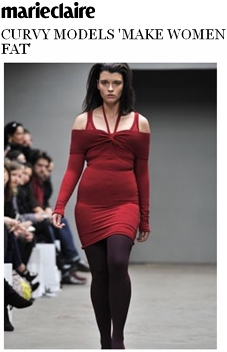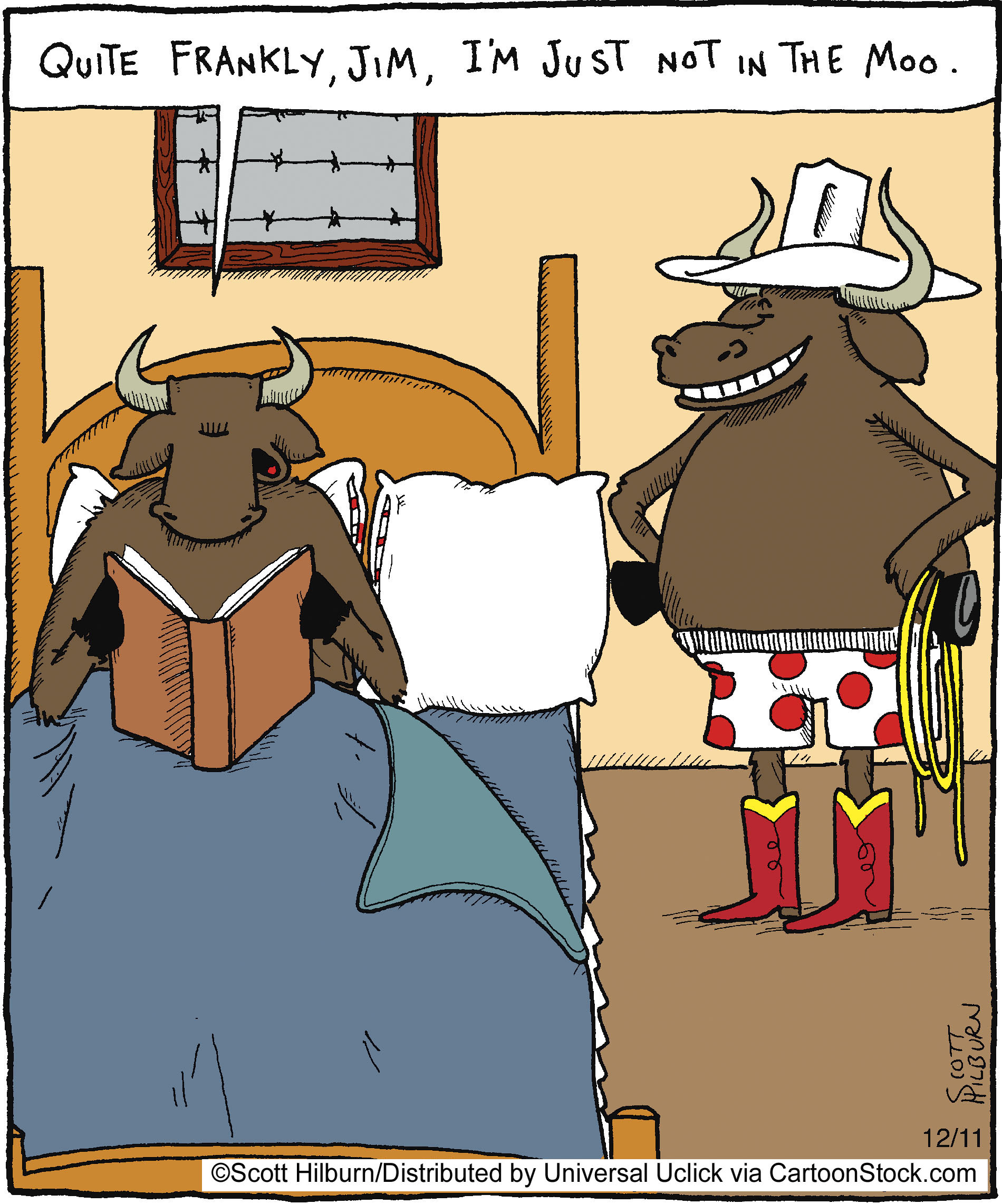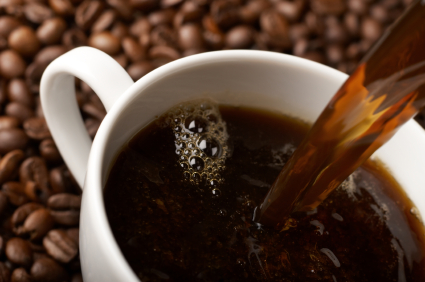Wednesday Bubble: Should Fatties Get a Room…and Other ‘Fine’ Assaults on Women… Guest Post by Dr. Brian Hughes
My friend Dr. Brian Hughes is at it again. “At what,” you ask? At identifying media assaults on women, on aging and on identities. You may recall that I ran Brian’s piece on ageism back in July of this year. And I am honored to run another post. Once again, I hope that you’ll show Brian some love and spread the word, not only about the post but also his work on The Science Bit Blog. Many thanks Brian!
I don’t know much about Marie Claire, but it appears to be some sort of magazine/website for people who hate women. At least, that’s the conclusion I drew from reading this story in their UK edition’s Health News section: “Women Think About Food More Than Sex“. In genre terms, this is something of a high concept piece, one of those articles that sums up everything it has to offer within the phrasing of its title alone (a bit like “Snakes on a Plane“).
So what did they find? Firstly, a full 25% of women ”admitted” that dieting was more important to them than their intimate relationships. In fact, get this:
…ten per cent would feel guiltier straying from their diet than being unfaithful to their partner.
That’s right. Marital (or relationship) infidelity — the stuff of epic romantic drama at least since the mythology of the ancient Greeks — is actually not that significant after all. What matters more is diet adherence. So, while Hester Prynne appeared somewhat perturbed throughout The Scarlet Letter, at least all she had to deal with was the stigma of her sexual indiscretion. Imagine if the townsfolk found out about that extra chocolate biscuit she used to scoff during coffee breaks…
Here are some more findings:
The most common reason for women in the UK to start a diet is to get the perfect beach body–while one in seven say cruel taunts are the reason they reign [sic] in their eating.
So women become self-conscious about their bodies due to beach paranoia andtaunting, eh? Well I guess that has nothing at all to do with articles appearing in magazines. Magazines like Marie Claire, for example…
How about these delightful pieces: “Are Leggings Making You Fat?“; “Could Your Fridge Be Making You Fat?“; “Curvy Models ‘Make Women Fat’“; “Diets That Make You Fat“; “Healthy Foods That Make You Fat“; “Is Your Air Conditioner Making You Fat?“; “Can A Common Virus Really Make You Fat?“; “3 Surprising Things That Make You Fat” (stilettos, your partner’s education, and boredom, apparently); “3 Fats That Make You Skinny” (ooh-er, now I’m confused); “10 Best Celebrity Beach Bodies“; ”From Flab To Fab: Your Holiday Survival Guide“; and “Get A Beach Body Fast“.
Uh huh. No grounds for paranoia or for beach-body neurosis there at all.
And as for cruel taunts, how about this memorable Marie Claire column called ”Should ‘Fatties’ Get A Room?“ Here’s an excerpt:
So anyway yes, I think I’d be grossed out if I had to watch two characters with rolls and rolls of fat kissing each other…because I’d be grossed out if I had to watch them doing anything. To be brutally honest, even in real life, I find it aesthetically displeasing to watch a very, very fat person simply walk across a room…
I think I understand why “one in seven (UK) women” modify their eating due to “cruel taunts“. They are obviously Marie Claire readers.
Still, while all that looks pretty terrible and offensive, at least Marie Claire quote a nutritionist to advise readers that “Dieting should never become an obsession“. So that’s alright then. Hands washed.
As it happens, “women think about food more than sex” is a well phrased, nicely falsifiable hypothesis. Either it is true or it is not. All that we need is data from a sample of women that is both large and statistically representative of the general population, regarding (a) the extent to which they think about food and (b) the extent to which they think about sex. Then we can do a simple statistical test tocompare these two values in order to determine which subject, on average, is thought about the most.
But of course, that’s not what we get here. Instead we have a pretty standard population-based survey study, with minimalist description of methodological details. Marie Claire report the findings as “Health News“, presenting statistical factoids that imply a basis in a comprehensive dataset but avoiding anything as troublesome as even a sample size.
In fact, according to the UK Press Association, the study examined responses from over 1,200 women, which sounds comprehensive enough. However, we are not told what questions were asked or what other findings the researchers discovered. This is because the study is not actually a piece of formal science. Rather, it’s a bog standard market research survey conducted by a private company who have a commercially vested interest in reporting particular results.
The survey is brought to us by Atkins, the people who make a profit every time a woman buys one of their dieting products. They seem to churn out lots of this type of research (see here, here, and here), all of which goes directly to newswires and yields findings that encourage women to turn dieting into an obsession. And thatnutritionist that Marie Claire get to warn women not to turn dieting into an obsession? Yeah, well she works for Atkins. In fact, she’s their “Chief Nutritionist“.
 Guess which one of these corporate value statements is my favourite
Guess which one of these corporate value statements is my favouriteWe’ve been here before. Pseudoscience in the service of corporate greed is depressing enough on its own. But it is truly amazing how women’s magazines and media outlets become complicit in this baloney. Instead of providing a service that is of actual benefit to women, these magazines end up assisting a corporate marketing strategy designed to maximize profits by generating and exploiting reader confusion.
Hey, for all I know (and I don’t), women might well think more about food than about sex. But let’s just remember this. Women’s magazines think more about their profitable relationships with corporate advertisers than about the edification — or mental health — of their readers.
Yeah! Go women!
About the author…
Dr Brian Hughes is a lecturer in Psychology at the National University of Ireland, Galway and author of Conceptual and Historical Issues in Psychology (Prentice Hall, 2011). When he is not writing or lecturing, you can find him lending his views on Twitter.
Read MoreShe works harder for the money
Awhile back, I wrote a post about how menopause impacts our occupational health and the need for greater awareness among managers of the types of health challenges that their middle aged female employees might be going through. This issue is evidently an ongoing hot button, as it has popped up again in a study that is current online at the Menopause journal site.
There are several conditions that affect work participation and demands, including menopause. And although there is some indication that abseenteeism is highest among women 45 years and older compared to their male contemporaries, the reasons have not been entirely elucidated. By gaining a better understanding of the factors that influence the balance between resources and work demands, there may be a greater openness to understanding and managing expectations by both the employee and the employer.
To explore this further, and using two scientific scales as a foundation, researchers looked into the severity and frequency of psychological, somatic, vasomotor and sexual symptoms and their potential impact on physical and mental work demands, health status and resources in208 women between the ages of 44 and 6o Additionally, they evaluated individual and lifestyle factors that might skew results, as it has been shown previously that among both men and women, lower education, older age, overweight, smoking and lack of exercise all negatively affected work ability.
The result? there was a negative and significant association between menopausal symptoms and work ability. Moreover, even after theyadjusted for some of the factors mentioned above, they found total work ability scores declined by almost a half a point for every one point on the total symptoms scale score. Mental health played a huge role as did somatic symptoms such as sleep disturbances, insomnia, joint pain or mood swings.
If these findings are extrapolated to real world situations, workplace interventions such as yoga breaks, exercise and stress reduction strategies, coupled with a self awareness of overall health and how symptoms detract from that (or not) are simple first steps towards finding a solution and improving work ability. The other piece of this, however, i.e. to openly communicate to our work colleagues, our managers, our partners and our friends how productivity and our relationships may be suffering and actively involve them in finding solutions, might not be so simple.
Often, one of first thing that’s pulled out of the aging hat is the fear that an employee is easily replaced. This has never been truer than in today’s economic environment where the numbers of willing and able workers are stacked against those who are holding onto their jobs by a string and a prayer. As a menopausal woman, do you really want to hand your employer a reason to replace you? I’m betting that the answer is no. Consequently, I am unclear about the best strategy for finding the elusive balance between work ability, resources and symptoms.
Any thoughts or ideas? I’d love to hear them. Let’s get a dialogue going, particularly if you are working harder for the money because of symptoms.
Read MoreWednesday Bubble: Timeout
Back in 2009 I posted a story about a woman’s death being blamed on menopause. It seems especially poignant a day after World Menopause Day, a day unlike any others, when we put down our prejudices and celebrate everything menopause.
As my grandmother would say “oy vey.”
How about we focus on how, as women, we are constantly manipulated by ‘disinterested’ parties? How about we call “timeout?”
A bit of context…
In 2009, the BBC ran a story about a woman who committed suicide. The headline read:
“Woman’s Death Blamed on Menopause.”
“A woman who refused to take hormone replacement therapy died while suffering a menopausal episode, an inquest had heard. Margaret Drew…was killed when she walked out of her family home on to a nearby railway line and was hit by a train…There is no trigger to this at all, except hormones making her do things that she normally wouldn’t do, Dr. Carlyon [Cornwall Coroner) concluded…”
Menopause. The silent killer. Oh really? Drew’s husband claims that his wife was “delightful, lovely and friendly” 99% of the time; the other 1% she’d become “totally irrational.” Yet, she refused to try HRT, he says. On the day of her suicide, he said that his wife was “clearly angry about something.”
Something.
Obviously, the conclusion is that that the “something” is hormones. This reminds me of vintage advertising copy that conveys the simple message that a pill a day can cure all that ails, wipe away the tears, mood swings and instability so that women can “transition without tears” (or better yet, without killing themselves).
Notably, a search in the National Library of Medicine’s PubMed database turned up only one recent study specifically dealing with suicide ideation across reproductive stages. In it, researchers compared data in 8,794 women, and found an increased risk of thinking about suicide among women during perimenopause, not before or after entering menopause. These findings remained after controlling for risk factors such as anxiety and mood disorders. HOWEVER, the researchers noted that the study design did not allow them to form any definitive conclusions about the specific reasons for thinking about suicide.
Another search yielded information that the risk for a major depression increases during perimenopause, primarily as the direct result of vasomotor symptoms. The same does not hold true for women before menopause begins or once they enter menopause. Note that while major depression is a risk factor for suicide, not everyone who is depressed will actually kill themselves.
Are hormonal fluctuations the sole cause of such deep unhappiness that women want to kill themselves? Or their careers?
Let’s look at a more recent story that appeared this week in the Denver Post.
“Former Elbert County assessor blames menopause medications for crimes, is sentenced to 60 days in jail, fined $10,000”
“Elbert County Judge Jeffrey Holmes might have thrown the book at former county assessor P.J. Trostel just for her management skills alone. Instead, he sentenced Trostel today to 60 days in county jail, three years of probation and 200 hours of community service on two felony counts…In asking for leniency, Trostel and her lawyer said a variety of factors led her to make bad decisions. Those included depression, symptoms from menopause, medications and stress from family and work. “Some of the things I don’t even have an answer,” Trostel said. “I know I made terrible judgments and decisions.”
It sounds as though Trostel would have done better with different legal representation. And a sounder argument.
And while Trostel is chewing on that concept for the next six years while incarcerated, perhaps we can start to change the paradigm and focus on the ills of the Menopause Industrial Complex, disinterested parties who perpetuate societal myths that menopause is a disease that requires treatment and that as women, our attitudes, belief systems and actions are hormonally-based and driven. That we are hysterical beings who need guidance on how to find our way and fulfill our dreams, realize our paths, but only if we calm down. That we can’t hold a job down, keep a marriage intact or play nicely with others. That we need a timeout (this would entail a long, long time, by the way).
Seriously though, a timeout from the hype would be a welcome addition to the change, don’t you think?
Read More
Health, wellbeing and social support. Give to the Max is setting a new revolution in motion…
I spend a lot of time on this blog writing about health and wellbeing and how the foundation for the two starts (and ends) with social support. Indeed, research has shown that women’s innate ability to nurture and nourish ties, coupled with overall satisfaction with work significantly predicts wellbeing especially during midlife and over the menopausal transition. It may even affect how long we live. Nowhere is this more important than in the communities where we reside because as much as many of us complain about how busy we are, there is a deep, soul stroking satisfaction in being able to help one another.
That is why it saddens me when I witness women building one another up in the community only to tear one another down in the workplace.
A line from a wonderful article that appeared in the New York Times in 2009 acknowledged certain stereotypes continue to perpetuate bad behavior. And, that as Author Peggy Klaus so aptly wrote, “the pink elephant is lurking in the room and we pretend it’s not there.”
Klaus’ point was that rather than help build each other’s careers, women often work to derail each other, engaging in “verbal abuse, job sabotage, misuse of authority and destroying of relationships.” She cited data suggesting that this type of behavior is directed from women to women more than 70% of the time, while the men who are “bullies in the workplace,” direct their aggression equally to both genders.
She encouraged us however, not to determine the why but rather, engage one another to put an end to this type of behavior.
Here’s an idea. Let’s start by supporting and building more power, self sufficiency and emotional equity from within businesses and from the top down. In other words, why not make an effort to support female-owned/founded businesses in our communities, especially those businesses that are working to eliminate inequities and promote the very qualities that improve health and wellbeing?
I recently learned that there are several female-founded nonprofit organizations in the region where I personally live that truly embody these principles:
- Suited for Change Founded in 1992, Suited for Change provides professional clothing, career and life skills education to low-income women in order to increase employment and job retention potential. Their clientele include homeless women, survivors of domestic violence, teen mothers, senior citizens, returning citizens, and women who have overcome addiction.
- Back on my Feet DC is an organization that promotes self sufficiency of homeless women (and men) — not through provision of shelter and food — but through physical activity, i.e. a running program to build confidence strength and self esteem, and teach the value of hard work, equality, respect, teamwork and leadership.
These nonprofits are only two examples of female-founded organizations that work to build self efficiency from the ground up and the top down, helping thousands of individuals learn the value of self assurance. mutual respect and support. I can only imagine what hundreds of other organizations are likewise doing to break down barriers and build wellbeing.
Want to help me find out?
If you know a local nonprofit that could use some extra support. then you need to know about Give to the Max. And if you are ready to engage other women to learn how we can consistently build one another up, then you will want to know about Give to the Max.
On November 9, thousands of organizations and residents in the region are uniting to take part in Give to the Max Day, a one-day regional online fundraiser to support local nonprofit programs. Give to the Max provides DC, Maryland and Virginia 501 (c)(3) nonprofit organizations visibility and even a lasting web presence to conduct ongoing fundraising initiatives after November 9. Most importantly, however, it’s a fantastic way for the community to give back and to support one of the region’s most important economic drivers at a time when the economy is taking a toll on charitable giving and simultatneously creating overwhelming demands for social services. For women, in particular, it’s a great start to breaking down the barriers that are destroying us in the workplace and finding ways to improve how we treat one another and why.
However, this day is not simply about women and women-owned nonprofits; an ‘Eight Neighbors Group’ alliance of the area’s leading nonprofit and civic organizations (Center for Nonprofit Advancement, Greater Washington Board of Trade, Leadership Greater Washington, Metropolitan Washington Council of Governments, Nonprofit Roundtable of Greater Washington and the Washington Regional Association of Grantmakers) have joined forces with the online fundraiser Razoo, The Community Foundation for the National Capital Region and the United Way of the National Capital Area to insure that nonprofits have an opportunity to raise thousands of dollars in donations and grants on a single day.
But why should you care if you don’t live in the DC/MD/VA region?
Give to the Max is just a start, an incentive for other other regions around the country to take back the health of their communities and leverage the individual for the collective wellbeing. As women, we have an opportunity to engage one another to end destructive behavior — not only in the workplace, but where we live.
Health and wellbeing start from where we all dwell; the heart. Let’s Give to the Max on November 9 and set a new revolution in motion.
Read More
Wednesday Bubble: Are you in the moo? Sex and a sense of purpose
What are we bursting this week? How about midlife and sexual desire. Frankly, I’ve got sex on the brain, sex in midlife, that is. And what we need to do to insure that it continues to be enjoyable, that we desire it and that we please our partners as much as we hope that they please us. Consequently, I am reposting this piece from earlier in the year, with the hope that with a sense of purpose, you’ll become more in the moo. Or mood. Whatever the case may be.
Sexual desire. In midlife, sexual function and sexual desire aren’t well understood, primarily because there are so many factors that enter into equation. This may be why certain silver bullets, like a female viagra, has failed to show any significant improvements in the desire department. And yet, researchers continue to accrue more information about the things that influence desire in women, ranging from the quality of intimate relationships to social support and overall wellbeing. The manufacturer who discovers a pill that addresses all of these will have struck gold. Meanwhile, back in reality, as many as 75% of women in midlife rate sexual health as important enough to warrant further exploration.
Fortunately, we may have another piece of the puzzle: ‘sense of purpose,’ which appears to be associated with greater wellbeing, happiness, life satisfaction, self-esteem, personal growth and optimism. A sense of purpose also appears to improve health, prevent certain diseases and may even improve cognitive function, thereby staving off mental diseases associated with aging. In a study that appears in the online version of Menopause, 459 menopausal women who were sexually active with a partner were followed over three years. Each year, they were asked about their emotional wellbeing (including their general mood, anxiety and depression as well as how often they engaged in and enjoyed sexual activity (specifically desire, type of activity and hugging and kissing). In the final year, they took a test that rated their sense of purpose on a five point scale ranging from ‘there is not enough purpose in my life’ to ‘the things I do are all worthwhile.’
The findings?
A greater sense of purpose equaled a great enjoyment of sexual activities, independent and regardless of other specific life circumstances. In other words, psychosocial functioning, e.g. social support, quality intimacy and overall wellbeing influenced the quality of these women’s sexual lives. On the other hand, menopausal status and use of hormone therapy did not appear to play a significant role in how often women engaged in sex or if they enjoyed it. This is important, as it means that psychosocial wellbeing may ultimately be more important than hormones.
In so far as the desire to engage? Women who were younger, had more social support, felt better about themselves and weren’t suffering from vaginal dryness tended to want sex more than their older peers who didn’t enjoy these factors.
Not surprisingly, many of the factors that researchers stress may help desire and engagement are associated with greater nitric oxide levels, which Dr. Christina Northrup says can help combat sexual dysfunction and improve pleasure.
When it comes to sex in midlife? It may help to think ‘sense of purpose,’ a real sense of purpose, now. (Poetic license, Chrissie!) I’m all for it if improves activity and desire without drugs.
Read MoreWednesday Bubble: chase the midlife blues away with a cup of java?
Coffee. The morning elixir that oh, so many of us rely on. Did you know that caffeine is the world’s most frequently ingested psychoactive substance?!
We’ve heard a lot about the blues and depression during midlife and menopause, with some experts saying that the two are connected and others, that they are not. However, regardless of whether or not menopause increases the risk for depression, it is clear that depression affects twice as many women as men, and at least 20% of all US women at some point during their lifetime. Hence, if there is an easy way to boost the success of antidepressants or behavioral or other strategies, I’m all for it. And it appears that coffee may be the part of the solution.
Coffee? Really?
In a newly published study in the esteemed Archives of Internal Medicine, researchers say that they followed over 50,000 women and examined their food intake including how often they drank caffeinated and decaffeinated coffee, tea and soft drinks and and ate chocolate. During the 10 years of the study, researchers identified slightly over 2,000 cases of depression. However, it appeared that drinking two to three cups of coffee daily reduced the risk of developing depression by 15% compared to drinking one cup a day or less. Women who drank four or more cups a day had a decreased risk of 20%. And decaffeinated beverages? No dice.
In so far as this study goes, it’s not conclusive and it could be possible that mildly depressed women drink less coffee. And keep in mind that too much of a good thing is well, too much. Studies have shown that long-term consumption of caffeine can lead to tolerance, meaning that you need greater amounts to achieve the effects that many of us crave. Nevertheless, so far, the results show that coffee may very well be mildly protective against depression.
English playwright and theatre director John Van Druten once said, “I think if I were a woman I’d wear coffee as a perfume.” I think I’d rather just drink it than wear it!
Read More











